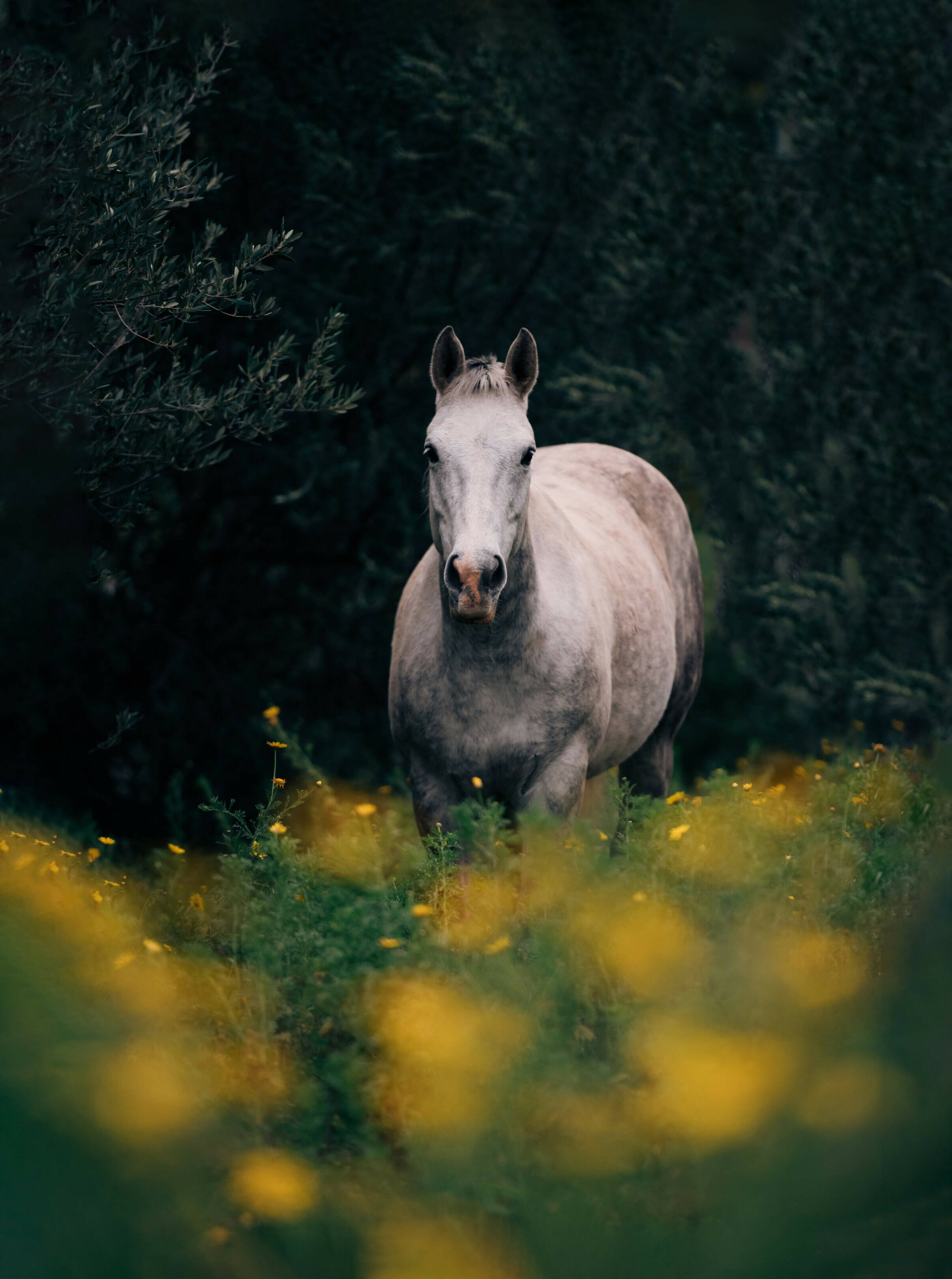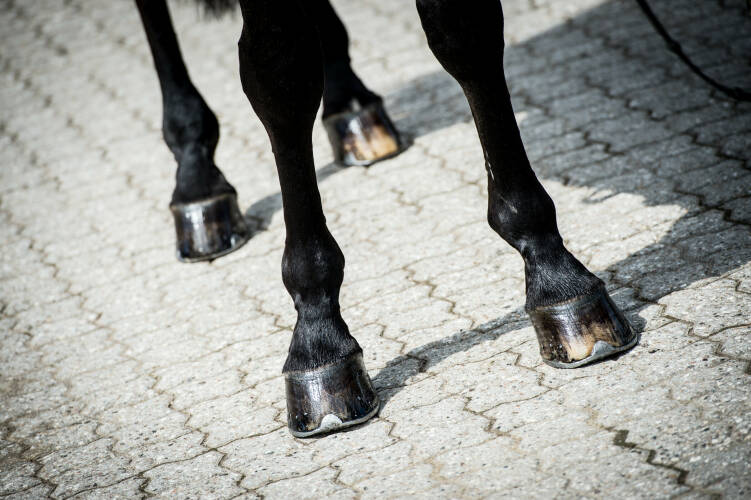
By Tina Bjerre Nielsen // Foto: Kee Frandsen, Den Smukke Hut
What is laminitis really? Does the word get you thinking about a fat little pony that has eaten far too much grass? That is often the scenario, but there are also other circumstances that can lead to the painful condition. In this article you will get seven truths about laminitis that can hopefully help you make sure that your horse steers clear of the feared disease.

It is far from just the grass during spring or summer that can be held accountable. The condition can also arise if the horse har overeaten, has had a change in feed, has overburdened its hooves, is overweight or generally eats feed that contains too much sugar or starch. In addition, uterine inflammation or metabolic diseases can be the cause. Nearly 90 % of all horses with laminitis are assumed to suffer from metabolic diseases.
Even though it is often thrifty horses who tend to gain weight easily, especially ponies, who are predisposed to laminitis, horses of all breeds and ages can get it.
Laminitis arises when an inflammation of the laminae of the foot, the soft tissue structures that attach the coffin or pedal bone of the foot to the hoof wall, arises. The inflammation and damage to the laminae causes extreme pain and makes the coffin bone in the hoof unstable. In severe cases the condition can lead to complete separation and rotation of the pedal bone within the hoof wall.

Horses with overgrown hooves are often more predisposed to the condition than horses with well managed hooves. It is therefore important that any horse is visited by the farrier every 6-8 weeks and that the hooves are kept healthy in general.
Hay and other kinds of forage can contain more sugar than you might think. For a healthy horse, it is usually not something to be concerned about. But if you have a horse that might be predisposed to laminitis, it makes sense to find out how much sugar there is in the hay that you buy for your horse. A lot of dealers of hay offer hay analysis reports.
Horses that have laminitis usually have symptoms in the front legs. That might be discoved by the horse putting all of its weight on the hind legs and putting the front legs forward to relieve them. However, the condition can also occur in the hind legs. This can be harder to notice because the horse in general does not put as much weight on the hind legs. Symptoms like taking small steps and lacking flow in movement might be what gives the condition away. Also, the horse might try to avoid putting weight on the toe. This can be discovered by a clicking sound when the horse walks.

Do not see it as a death sentence if your horse gets laminitis. Yes, the condition is feared because it can have serious consequenses. But it may just be that the horse simply needs treatment and ease in order to get well. Some horses can feel ok after a week while others can suffer so gravely that the only option is saying goodbye. If you horse should get laminitis, the best option is to feed it correctly and create a soft bedding.
Some horses might get laminitis simply by walking on a hard surface like frozen soil or roads. However, it does not mean that you should skip your walks or avoid turning your horse out in cold weather. But if your horse has thin soles or previously has had laminitis, it is a good idea to keep it on soft bedding or surface.


What is laminitis really? Does the word get you thinking about a fat little pony that has eaten far too much grass? That is often the scenario, but there are also other circumstances that can lead to the painful condition. In this article you will get seven truths about laminitis that can hopefully help you make sure that your horse steers clear of the feared disease.
By Tina Bjerre Nielsen // Foto: Kee Frandsen, Den Smukke Hut

Laminitis arises when an inflammation of the laminae of the foot, the soft tissue structures that attach the coffin or pedal bone of the foot to the hoof wall, arises. The inflammation and damage to the laminae causes extreme pain and makes the coffin bone in the hoof unstable. In severe cases the condition can lead to complete separation and rotation of the pedal bone within the hoof wall.
It is far from just the grass during spring or summer that can be held accountable. The condition can also arise if the horse har overeaten, has had a change in feed, has overburdened its hooves, is overweight or generally eats feed that contains too much sugar or starch. In addition, uterine inflammation or metabolic diseases can be the cause. Nearly 90 % of all horses with laminitis are assumed to suffer from metabolic diseases.
Even though it is often thrifty horses who tend to gain weight easily, especially ponies, who are predisposed to laminitis, horses of all breeds and ages can get it.

Horses with overgrown hooves are often more predisposed to the condition than horses with well managed hooves. It is therefore important that any horse is visited by the farrier every 6-8 weeks and that the hooves are kept healthy in general.
Hay and other kinds of forage can contain more sugar than you might think. For a healthy horse, it is usually not something to be concerned about. But if you have a horse that might be predisposed to laminitis, it makes sense to find out how much sugar there is in the hay that you buy for your horse. A lot of dealers of hay offer hay analysis reports.
Horses that have laminitis usually have symptoms in the front legs. That might be discoved by the horse putting all of its weight on the hind legs and putting the front legs forward to relieve them. However, the condition can also occur in the hind legs. This can be harder to notice because the horse in general does not put as much weight on the hind legs. Symptoms like taking small steps and lacking flow in movement might be what gives the condition away. Also, the horse might try to avoid putting weight on the toe. This can be discovered by a clicking sound when the horse walks.

Do not see it as a death sentence if your horse gets laminitis. Yes, the condition is feared because it can have serious consequenses. But it may just be that the horse simply needs treatment and ease in order to get well. Some horses can feel ok after a week while others can suffer so gravely that the only option is saying goodbye. If you horse should get laminitis, the best option is to feed it correctly and create a soft bedding.
Some horses might get laminitis simply by walking on a hard surface like frozen soil or roads. However, it does not mean that you should skip your walks or avoid turning your horse out in cold weather. But if your horse has thin soles or previously has had laminitis, it is a good idea to keep it on soft bedding or surface.

